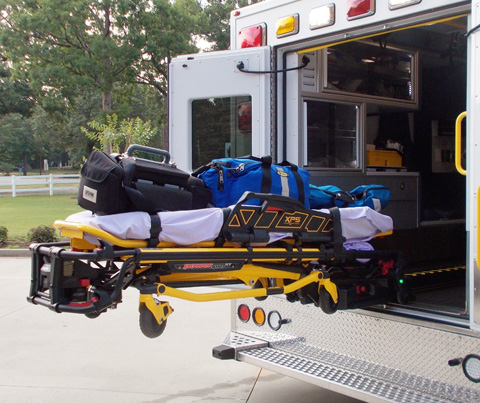Pelzer EMS recently obtained The Stryker PowerLoad system which will eliminate the problems involved in transporting large or obese patients.
By Stan Welch
The question of obesity and general health is something of a chicken and egg conundrum. Which came first? Obesity can lead to a number of related issues, such as coronary disease, diabetes, high blood pressure and other problems. Conversely, some of those conditions can then exacerbate the obesity.
To the EMS personnel who respond when those problems take their toll, obesity among their patients can cause another, equally immediate problem. That problem is how to safely and efficiently manage and transport a patient who might weigh well over three hundred pounds, if not more.
The Pelzer Rescue Squad recently acquired a piece of equipment that simply takes that problem out of play. The Stryker Power Load System is a device that mounts in the floor of an ambulance, and which extends out for attachment to the stretcher, which it then retrieves into the truck, with little physical demand on the personnel.
The device is a recent development which works in concert with the Power Pro stretcher, which also addresses the same problem – overweight patients who cannot be easily handled through conventional physical means. The Power Load system attaches to the Power Pro, which operates on a heavy duty SUV battery which lifts the stretcher to the proper height for initial transport to the ambulance, and for secondary transfer of the stretcher and patient into the ambulance.
Once the stretcher is properly attached to the loading device, the device draws it into the ambulance and locks into place. Upon arrival at the hospital, the process is reversed. The Pelzer squad is the only unit in the Upstate currently using the two part system, though the power stretchers are common. The next closess EMS unit using the system is at the Savannah River Plant near Barnwell, SC.
Cost is clearly a factor in that scarcity of the units across the state. The stretchers cost fifteen thousand dollars apiece, while the second component costs twice that. Tony Vinson, operations manager for the squad, acknowledges that the price is high; but he points out that workman’s compensation claims for back injuries, which are not unusual, can quickly surpass that amount.
“We also are able to safely manage the patient with this system, without worrying about a mishap involving either the patient or our personnel. And hopefully, as more units acquire these devices, the cost will come down.”
The power stretcher is rated for seven hundred pounds, while the Power Load device is rated for an additional one hundred eighty pounds, to include the weight of the stretcher itself. Vinson said the unit has been employed several times in the short time the Squad has had it, and has functioned flawlessly.

















